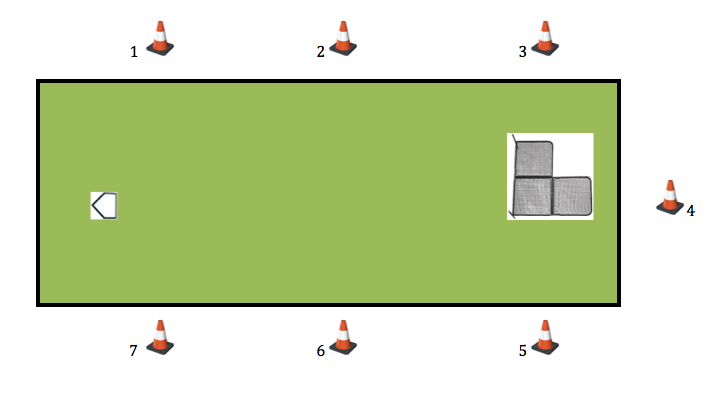Tunnel and cone drill
October 29, 2012 by Coach McCreary
Filed under Hitting, Off-Season
The winter months are approaching rapidly. Ultimately, that means lots of swings using indoor batting tunnels. These tunnels are terrific to use but can lead to boredom if players just take the same old swing over and over. Of course, for many hitters, this repetitive swing is exactly what they need to develop muscle memory. However, part of being a good hitter involves good bat control. Good bat control involves being able to hit to all parts of the field. A hitter with good bat control does not have to hit .400 to be valuable to a team. Putting the ball on the ground, hitting behind runners, and succeeding at the hit-and-run have value without getting hits. A batting tunnel is a great place to work on this bat control. The picture below shows how a hitting tunnel can be used along with some cones.
The cones aligned outside the tunnel are targets for the hitter to hit towards. If the batter is by himself, he can adjust a batting tee to create the proper bat angle in order to hit the ball well to each tee location. If a coach is throwing BP, the coach can call out a tee number where he’d like to see the hitter hit towards.
Below explains how each tee location represents different game situations:
#’s 1 and 7: These tee locations for righties and lefties can be used to represent two strike pitches where the hitter waits as long as possible before making contact. Yes, the ball hit will actually be a foul ball if hit to those tees but it forces the batter to get the feel of waiting as long as possible on the pitch.
#’s 2 and 6: These cone positions are good for righties and lefties who need to work on improving bat speed and explosiveness to the ball. A righty would hit to #2 and a lefty would hit to #6. Turning on a pitch to smoke a ball down the line forces these hitters to clear their hips and get the barrel out front in order to pull the ball. Cone #6 is itself a good one for both righties and lefties who are trying to hit the hole at first base to move a runner from 1st to 3rd. Both of these cones are also good for working on two strike hitting if you hit to the opposite field cone. It’s just not as exaggerated as cones 1 and 7.
#3 and 5: These cones are good for practicing a good hit-and-run location for ground balls. Whether pulled or hit the opposite way, these ground balls keep the ball away from the second base area where a fielder will be when he covers second on the steal. These cones are also good for driving the ball into the outfield. Hitting towards a cone or hitting the area between these two cones (gap to gap) are good targets for overall successful hitting.
#4: This target is also good for overall hitting mechanics and skills. If players are focussing on just mechanical improvements with their swing, targeting the center of the field makes things more simple and promotes a good bat angle at contact.
If your indoor work needs a little boost, bring out the cones! If you don’t have cones, use helmets, hats, gloves, or any other markers you have available.






During your statement at the top of the page you mention muscle memory which is a misnomer, there is no such thing as muscle memory, one’s brain is ones command center which collects and controls one’s mental and physical actions, Muscles have no memory capabilities, prevention and muscle memory are two words that are consistently misused, also lactic acid build up during a pitchers outing or for that matter during a ball players game outing is a false belief, lactic acid does not build up in a ball players body during the course of a game or practice session, running players after games, pitchers in particular for that reason is the result of inadequate coaching knowledge which is my main pet peeve about coaches in general.
Great Base Ball-N to all
Don Ervin
dfervin32@yahoo.com
Yep. Lots of misnomers in baseball … “square it up,” “keep your eye on the ball,” “field with your feet,” “stay on top of the ball,” and of course “muscle memory.” Doesn’t mean they have no value though.